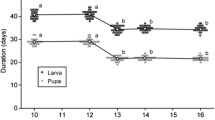Abstract
Pecten spine number has been studied in larvae of Aedes aegypti exposed during development to low temperatures or to DDT at the fourth instar, both of which caused substantial mortality. But neither contingency caused stabilising selection for spine number, in contrast to what was observed in a previous study when larvae were exposed to scum on the surface of the rearing medium. — Two larval colour morphs, yellow and brown, did not differ in spine number.
Similar content being viewed by others
References
Craig, G. B. Jr. & N. W. Gillham (1959). The inheritance of larvae pigmentation in Aedes aegypti. J. Hered. 50: 115.
Wood, R. J. (1970). The influence of y locus on DDT resistance in the mosquito Aedes aegypti L. Genet. Res. 16: 37–47.
Wood, R. J. (1975). Spine number of the pecten and comb of fourth instar larvae of Aedes aegypti L. Differences between populations. Genetica 46: 33–44.
Author information
Authors and Affiliations
Rights and permissions
About this article
Cite this article
Wood, R.J. The effect of DDT and rearing temperature on pecten spine number in larvae of the mosquito Aedes aegypti L.. Genetica 46, 45–48 (1990). https://doi.org/10.1007/BF00122516
Received:
Accepted:
Issue Date:
DOI: https://doi.org/10.1007/BF00122516




